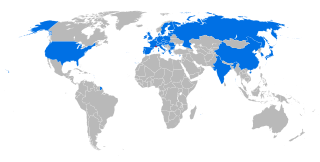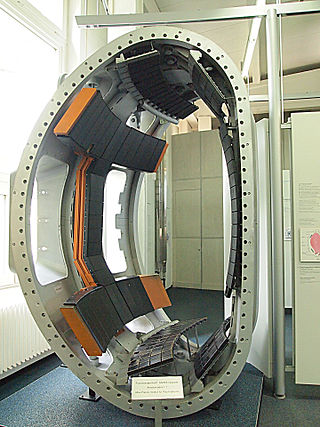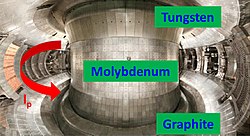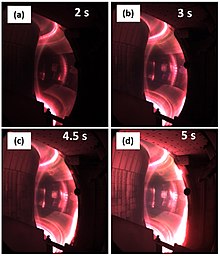
A tokamak is a device which uses a powerful magnetic field to confine plasma in the shape of a torus. The tokamak is one of several types of magnetic confinement devices being developed to produce controlled thermonuclear fusion power. As of 2016, it was the leading candidate for a practical fusion reactor. The word "tokamak" is derived from a Russian acronym meaning "toroidal chamber with magnetic coils".

Fusion power is a proposed form of power generation that would generate electricity by using heat from nuclear fusion reactions. In a fusion process, two lighter atomic nuclei combine to form a heavier nucleus, while releasing energy. Devices designed to harness this energy are known as fusion reactors. Research into fusion reactors began in the 1940s, but as of 2023, no device has reached net power.
This timeline of nuclear fusion is an incomplete chronological summary of significant events in the study and use of nuclear fusion.

The Joint European Torus, or JET, is an operational magnetically confined plasma physics experiment, located at Culham Centre for Fusion Energy in Oxfordshire, UK. Based on a tokamak design, the fusion research facility is a joint European project with a main purpose of opening the way to future nuclear fusion grid energy. At the time of its design JET was larger than any comparable machine.

ITER is an international nuclear fusion research and engineering megaproject aimed at creating energy through a fusion process similar to that of the Sun. Upon completion of construction of the main reactor and first plasma, planned for late 2025, it will be the world's largest magnetic confinement plasma physics experiment and the largest experimental tokamak nuclear fusion reactor. It is being built next to the Cadarache facility in southern France. ITER will be the largest of more than 100 fusion reactors built since the 1950s, with ten times the plasma volume of any other tokamak operating today.
JT-60 is a large research tokamak, the flagship of Japan's magnetic fusion program, previously run by the Japan Atomic Energy Research Institute (JAERI) and later by the Japan Atomic Energy Agency's (JAEA) Naka Fusion Institute in Ibaraki Prefecture. As of 2023 the device is known as JT-60SA and it is the largest operational superconducting tokamak in the world to date, and is build and operated jointly by Europe and Japan. SA stands for super advanced tokamak, including a D-shaped plasma cross-section, superconducting coils, and active feedback control.

The T-15 is a Russian nuclear fusion research reactor located at the Kurchatov Institute, which is based on the (Soviet-invented) tokamak design. It was the first industrial prototype fusion reactor to use superconducting magnets to control the plasma. These enormous superconducting magnets confined the plasma the reactor produced, but failed to sustain it for more than just a few seconds. Despite not being immediately applicable, this new technological advancement proved to the USSR that they were on the right path. In the original shape, a toroidal chamber design, it had a major radius of 2.43 m and minor radius 0.7 m.

Magnetic confinement fusion (MCF) is an approach to generate thermonuclear fusion power that uses magnetic fields to confine fusion fuel in the form of a plasma. Magnetic confinement is one of two major branches of controlled fusion research, along with inertial confinement fusion.
HT-7, or Hefei Tokamak-7, is an experimental superconducting tokamak nuclear fusion reactor built in Hefei, China, to investigate the process of developing fusion power. The HT-7 was developed with the assistance of Russia, and was based on the earlier T-7 tokamak reactor. The reactor was built by the Hefei-based Institute of Plasma Physics under the direction of the Chinese Academy of Sciences.

The National Spherical Torus Experiment (NSTX) is a magnetic fusion device based on the spherical tokamak concept. It was constructed by the Princeton Plasma Physics Laboratory (PPPL) in collaboration with the Oak Ridge National Laboratory, Columbia University, and the University of Washington at Seattle. It entered service in 1999. In 2012 it was shut down as part of an upgrade program and became NSTX-U, for Upgrade.

The KSTAR is a magnetic fusion device at the Korea Institute of Fusion Energy in Daejeon, South Korea. It is intended to study aspects of magnetic fusion energy that will be pertinent to the ITER fusion project as part of that country's contribution to the ITER effort. The project was approved in 1995, but construction was delayed by the East Asian financial crisis, which weakened the South Korean economy considerably; however, the project's construction phase was completed on September 14, 2007. The first plasma was achieved in June 2008.

ASDEX Upgrade is a divertor tokamak at the Max-Planck-Institut für Plasmaphysik, Garching that went into operation in 1991. At present, it is Germany's second largest fusion experiment after stellarator Wendelstein 7-X.
The beta of a plasma, symbolized by β, is the ratio of the plasma pressure (p = nkBT) to the magnetic pressure (pmag = B²/2μ0). The term is commonly used in studies of the Sun and Earth's magnetic field, and in the field of fusion power designs.
SST-1 is a plasma confinement experimental device in the Institute for Plasma Research (IPR), an autonomous research institute under Department of Atomic Energy, India. It belongs to a new generation of tokamaks with the major objective being steady state operation of an advanced configuration plasma. It has been designed as a medium-sized tokamak with superconducting magnets.
The GLAss Spherical Tokamak is a name given to a set of small spherical tokamaks located in Islamabad, Pakistan. They were developed by the Pakistan Atomic Energy Commission (PAEC) as part of the National Tokamak Fusion Program (NTFP) in 2008 and are primarily used for teaching and training purposes.
The ARC fusion reactor is a design for a compact fusion reactor developed by the Massachusetts Institute of Technology (MIT) Plasma Science and Fusion Center (PSFC). ARC aims to achieve an engineering breakeven of three. The key technical innovation is to use high-temperature superconducting magnets in place of ITER's low-temperature superconducting magnets. The proposed device would be about half the diameter of the ITER reactor and cheaper to build.
The history of nuclear fusion began early in the 20th century as an inquiry into how stars powered themselves and expanded to incorporate a broad inquiry into the nature of matter and energy, as potential applications expanded to include warfare, energy production and rocket propulsion.
The Compact Ignition Tokamak (CIT) was a plasma physics experiment that was designed but not built. It was designed by an inter-organizational team in the USA led by Princeton Plasma Physics Laboratory. The experiment was designed to achieve a self-sustaining Thermonuclear fusion reaction (ignition) in a Tokamak with the minimum possible budget.
The Tokamak Physics Experiment (TPX) was a plasma physics experiment that was designed but not built. It was designed by an inter-organizational team in the USA led by Princeton Plasma Physics Laboratory. The experiment was designed to test theories about how Tokamaks would behave in a high-performance, steady-state regime.












